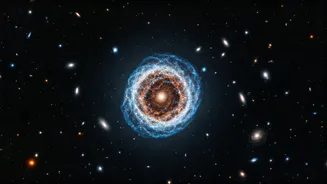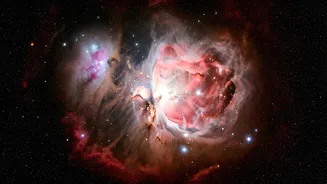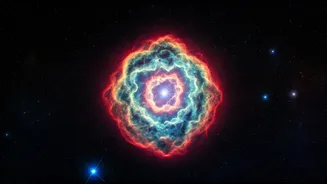Dark Matter Unveiled
Scientists have achieved a monumental feat by detecting the smallest clump of pure dark matter to date. This momentous discovery, made possible through
the use of gravitational lensing, opens a new window into the study of dark matter, a mysterious substance that makes up a significant portion of the universe's mass but remains invisible to us. The clump, a compact structure, is situated an astonishing 10 billion light-years away, highlighting the power of advanced astronomical techniques in probing the cosmos. This finding is instrumental in advancing our understanding of how dark matter is distributed throughout the universe, which subsequently affects the way galaxies and other celestial bodies are formed and interact. The ability to observe and study such minute structures provides unique data for theoretical models of dark matter, offering a clearer look at the way dark matter behaves and impacts the broader structure of the cosmos. The identification of this tiny clump is a major milestone in astrophysics, as it presents researchers with invaluable data to refine their models.
Gravitational Lensing Explained
Gravitational lensing played a pivotal role in this breakthrough. This phenomenon, which is a direct consequence of Einstein's theory of general relativity, is based on the concept that massive objects warp the fabric of spacetime, causing light to bend as it passes nearby. This bending effect acts like a cosmic magnifying glass, amplifying and distorting the light from distant objects, which allows astronomers to observe objects that would otherwise be too faint or small to detect. By analyzing how light is bent and shaped by gravitational lensing, scientists can map the distribution of mass, including dark matter, which doesn't emit light and is thus undetectable by conventional methods. The precision and sensitivity of gravitational lensing allow astronomers to identify and study tiny structures like this dark matter clump. This technique has transformed the way scientists study distant galaxies and provides insights into the existence of dark matter. This discovery underscores the importance of gravitational lensing as a tool to explore the intricacies of dark matter, contributing significantly to our overall knowledge of the universe’s composition.
Implications and Future Research
The discovery of this smallest dark matter clump is significant. The data gives scientists valuable information about how dark matter is distributed, how it clumps, and its interactions with other matter in the universe. Such information is crucial for testing and refining theoretical models of dark matter. Researchers can now compare the observations from the clump with predictions from the current models to identify areas for improvement or entirely new theories. Further investigation into this clump, and others potentially discovered through similar methods, is expected to provide deeper insights into the nature of dark matter and its role in the universe. The ability to identify these tiny structures is critical for understanding the evolution of the cosmos. Future research may focus on identifying more of these clumps to establish patterns in their distribution. They may also analyze the interactions of dark matter with ordinary matter to understand their influence on the formation of galaxies and large-scale structures in the universe. This will ultimately refine our understanding of the universe's formation and its ultimate destiny.














